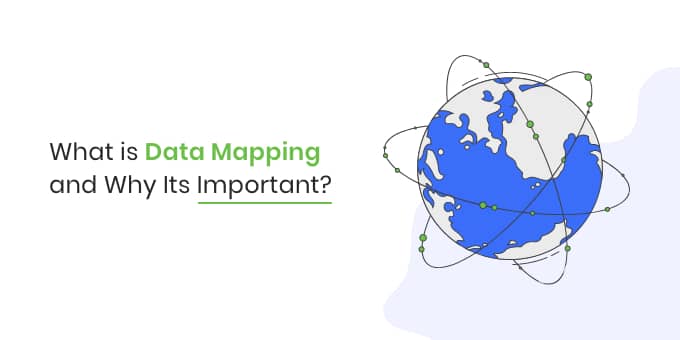What is Data Mapping
Data mapping involves transferring data from its source to related objective fields, such as mapping an individual’s name from one data source to their email, telephone, or address fields in another record. The purpose of Data Mapping is defined as
“Data mapping is important for an organisation to understand how the data that they hold relates to other elements or functions of the organisation, identifying key data sources and personnel responsible for it and identifying any gaps or risks and mitigation these gaps or risks to comply with the General Data Protection Regulation (GDPR).”
Depending on the number, pattern, essential keys, and outside keys of the social database information sources, database mappings can have a shifting level of intricacy. For instance, information from three database tables can join and plan an Excel goal.
Contingent upon the information on the executive’s needs of a venture and the capacities of the information planning programming. It is utilised to achieve a scope of information reconciliation and change errands.
importance of Data Mapping
To use the information correctly and gain value, data gathered from different outside and inner sources must be bound together and changed into a configuration appropriate for the operational and expository procedures. This is accomplished through data mapping, which is vital in different information processes.
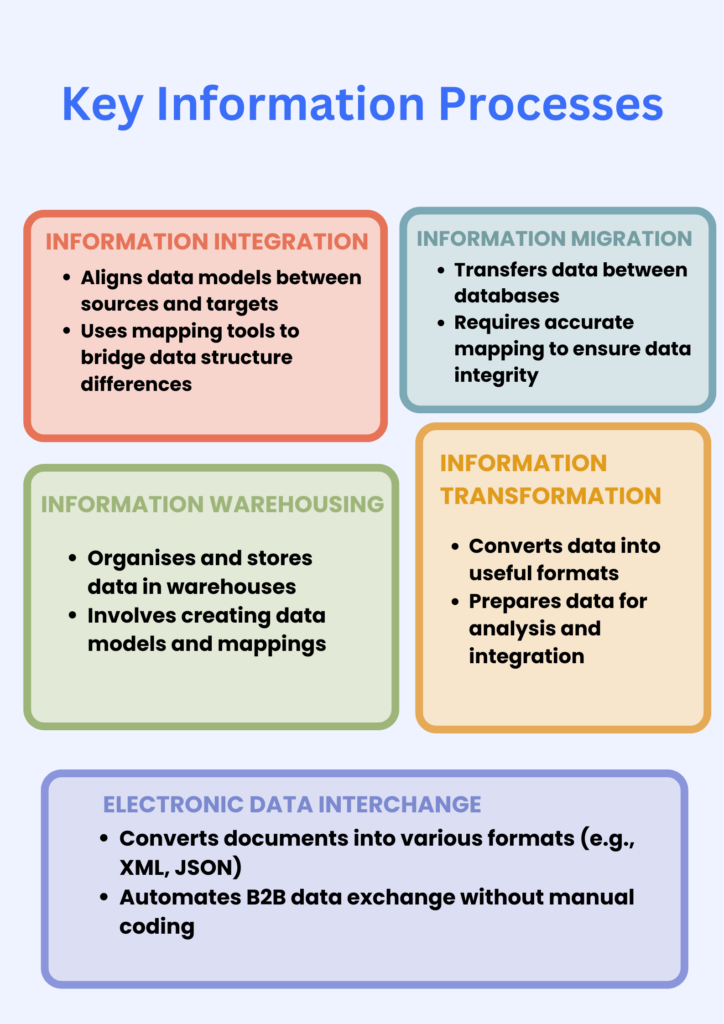
Information integration
The source and target information stores must have similar information models for a compelling information mix. Even so, it is common for any two information archives to have similar constructions.
Mapping instruments help connect the distinctions in the constructions of information source and goal, permitting organisations to combine data from various information focuses without any problem.
Information Migration
Information movement is moving information from one database to the next. While different advances are involved in this procedure, mapping between source and target is one of the most troublesome and tedious assignments, especially when done physically.
Mistaken and invalid mappings at this stage affect the exactness and culmination of information being relocated and can even prompt disappointment in the information movement venture. Thus, a sans-code planning arrangement that can mechanise the procedure is essential to move information to the goal effectively.
Information Warehousing
Information planning in an information distribution centre involves associating associates or traits. By utilising information planning, organisations can fabricate an intelligent information show and characterise how the information will be organised and stored in the information distribution centre.
The procedure also starts with gathering all the necessary data and understanding the source information. When that has been done, and an information planning archive is made, building the change leads and making mappings is straightforward with an information planning arrangement.
Information Transformation
Since big business information dwells in various areas and configurations, information change is fundamental to breaking data storehouses and drawing bits of knowledge. Information planning is the first step towards significant changes. It is done to create a system for what changes will be made to information before it reaches the objective database.
Electronic Data Interchange
Information planning plays a noteworthy role in EDI document change by converting the records into different configurations, such as XML, JSON, and Excel. An automatic information planning device permits the client to separate information from various sources and use worked-in changes and capacities to plan information for EDI positions without composing a single line of code. This performs consistent B2B information trade.
Challenges
Here’s a list of four primary data mappling challenges that companies may face in implementing data mapping initiatives

Complex, Manual Data Mapping Processes
In today’s complex world, companies struggle to keep up with the scale of their data environments. Data stewards must define strategic and systematic data maps. IT teams need careful planning, tools, and a clear data mapping roadmap.
These capabilities are necessary for the data mapping process to be manageable for your team. Automated software solutions are part of the modern approach that’s needed. They help you break through the clutter and create data maps with agility and accuracy.
Data Diversity
It’s not likely that you will be able to convert data into the actionable insights you need without the ability to handle the four “Vs” of modern data:
- Volume – Amount of data being generated
- Velocity – Speed at which data is being generated
- Variety – Various types of data being generated, which can broadly be grouped into three categories: structured data, semi-structured data, and unstructured data
- Veracity – Trustworthiness of the data
Once you map your data addressing the four “Vs,” you can unleash the fifth “V” — data value. With data value, you can drive deep analysis, accurate reporting and confident decision-making.
Poor Performance
If your data mapping needs to be corrected, your processing time and costs can increase. Data integration can help you better understand a use case and business outcome. But you need an intelligent recommendation engine to avoid unnecessary steps and tasks.
Your systems and staff may need help to keep up with data mapping challenges, and errors can occur. This slows down processing time and causes issues during data transfer. It also impacts data testing and implementation.
You can even lose data, costing more time and resources. Intelligent, automated data mapping can help you get the results you want.
Lack of Trust
You need visibility into end-to-end data movements and changes. Your team can trust your data or build plan with it.
Applications generate their data formats, and definitions may be different. That means you won’t be able to trust your data transformation
Information Mapping Techniques
Although a fundamental advance in any information-boarding procedure, information planning can be intricate and tedious.
Building mappings for information change and reconciliation is one way to interface information sources. Approving change information can take up noteworthy designer assets, especially when the procedure is done physically.
In light of the degree of robotisation, information planning procedures can be isolated into three kinds
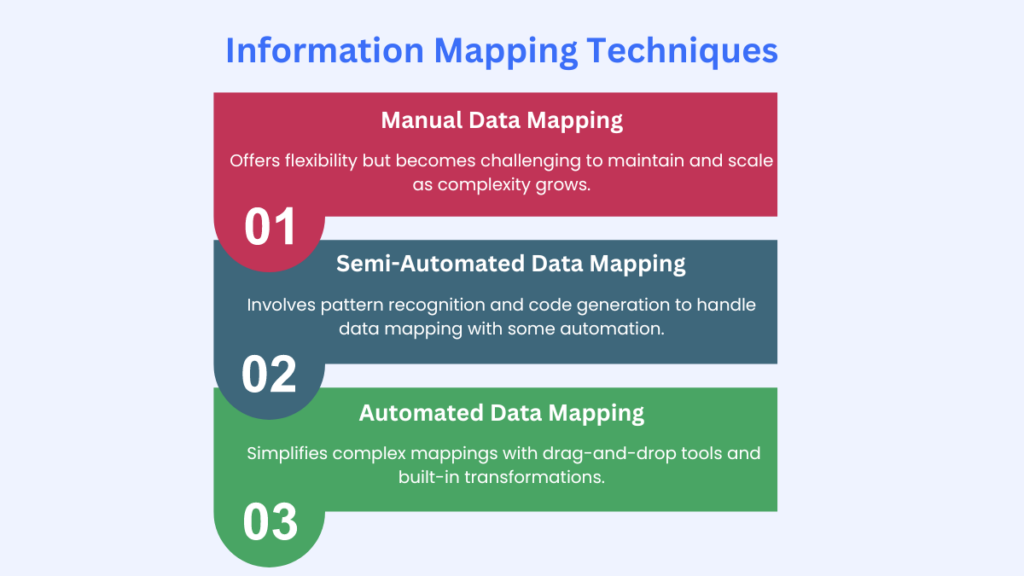
1. Manual Data Mapping
Manual information planning includes hand-coding the mappings between the information source and the target database. Even though hand-coded.
The manual information planning process offers boundless adaptability for one-of-a-kind planning situations at first. It can get testing to keep up and scale as the planning needs of the business develop complex.
2. Semi-Automated Data Mapping
Pattern planning frequently refers to a semi-computerised information planning strategy. The procedure includes recognising two semantically related information objects and constructing mappings between them.
For instance, to assemble mappings between the diagrams of Database 1 and Database 2, the potential matches that a designer can utilise incorporate Database1: StudentName≈Database2: Name and Database1: ID≈Database2: SSN.
When pattern planning is done, Java, C++, or C# code is created to accomplish the necessary information transformation errands. The programming language utilised may shift depending on the information planning device utilised.
3. Mechanized Data Mapping
Moreover, mechanised information planning apparatuses include a total without code condition for information planning undertakings of any multifaceted nature. Mappings between the information source and the target database are straightforward and simplified.
A robotised information planning apparatus additionally has worked in changes to change over information from XML to JSON, EDI to XML, XML to XLS, various levelled to level records, or any configuration without composing a solitary line of code.
Some undertaking grade information planning programming extends to process organisation, and employment opportunity booking highlights to robotise database planning.
Types of Data Mapping Tools
Data mapping instruments can separate into three wide types:
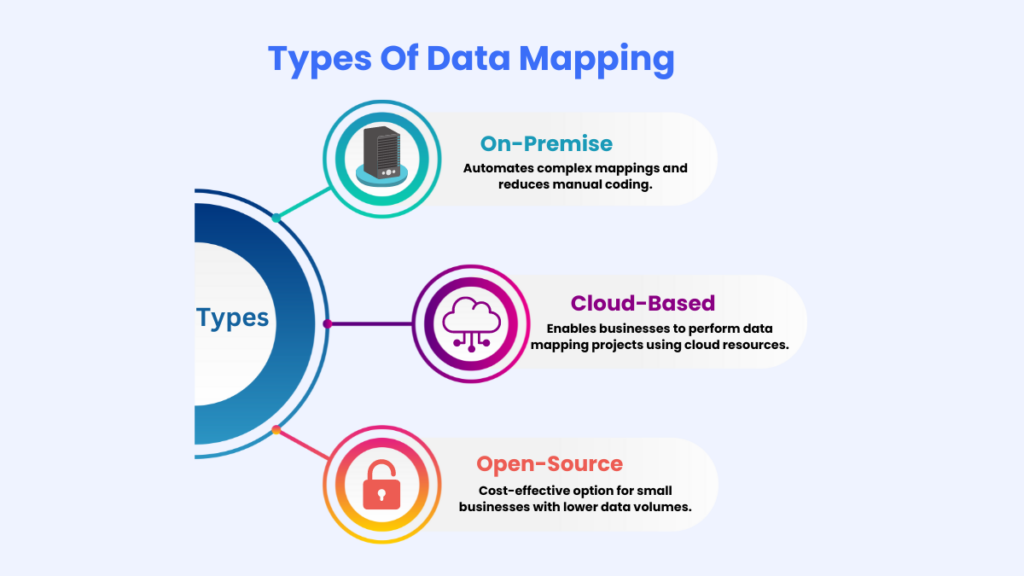
On-Premise: Such instruments facilitate on an organization’s server and local registering framework. Numerous on-premise information planning instruments dispose of the requirement for hand-coding to make complex mappings and computerize tedious assignments in the information planning process.
Cloud-Based: These devices influence cloud innovation to enable a business to play out its information planning ventures.
Open-Source: Open-source planning devices give a minimal effort option to on-premise information planning arrangements. These devices work better for independent companies with lower information volumes and easier use-cases.
How to Evaluate and Choose the Best Data Mapping Software?
Choosing the correct data mapping or information planning device that best fits the endeavour is essential to achieving any information reconciliation, information change, or information warehousing venture. Moreover, the procedure includes recognising unique information planning prerequisites for the business and must-have highlights.
On-Premise
Such devices facilitate an organisation’s server and local registering framework. Numerous on-premise information planning devices eliminate the requirement for hand-coding to make complex mappings and computerise monotonous assignments in the information planning process.
Cloud-Based
These apparatuses influence cloud innovation to enable a business to play out its information planning ventures.
Open-Source
Open-source planning apparatuses offer a minimal-effort alternative to on-premise information planning arrangements. These devices work better for independent companies with lower information volumes and more straightforward use cases.
What to look for in a data mapping tool
Cloud-based data mapping software tools are fast, flexible, and scalable, and they are built to handle demanding mapping needs without stretching the budget. While the features and functionality of a data mapping tool depend on the organisation’s needs, there are some everyday must-haves to look for.
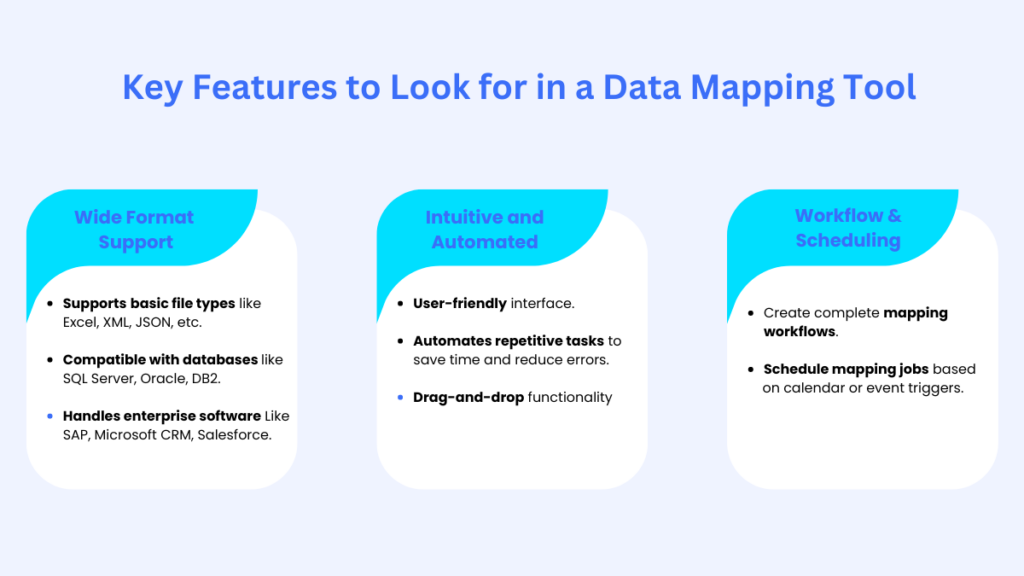
Wide format support
Most tools support basic file types such as Excel, delimited text files, XML, JSON, EBCDIC, and others. Look for a tool that handles standard formats in your environment, such as SQL Server, Sybase, Oracle, DB2, or other formats.
A good mapping tool will also handle enterprise software such as SAP, SAS, Marketo, Microsoft CRM, SugarCRM, or data from cloud services such as Salesforce or Database.com.
Intuitive and automated
An intuitive, cloud-based tool is designed to automate repetitive tasks to save time, lethargy, and the risk of human error. Look for drag-and-drop functionality that allows users to match fields and apply built-in transformation quickly, so no coding is required.
Workflow & scheduling
To round out automation capabilities, look for a tool to create a complete mapping workflow to schedule mapping jobs triggered by the calendar or an event.
Advanced-Data Mapping Techniques:
Data mapping has evolved beyond essential field matching. Today, advanced techniques like semantic mapping and machine learning integration are revolutionising how organisations handle data integration and transformation.
Semantic Mapping
Semantic mapping goes beyond simple field-to-field correspondence; it involves understanding the meaning and context of data elements across disparate sources.
Benefits:This approach not only enhances accuracy but also enables more nuanced data mapping transformations that align with specific business needs.
Machine Learning Integration
Machine learning, on the other hand, brings automation and intelligence to data mapping processes. By analysing patterns in data relationships and historical mappings, machine learning algorithms can dynamically suggest mappings, predict transformations, and adapt to evolving data structures.
Benefits:This capability saves time and improves the accuracy and agility of data mapping initiatives.
Case Studies: Real-Life Applications
Let’s look at actual-world examples of information mapping’s tangible effect on business operations. For example, a leading e-commerce platform utilised superior records mapping to streamline stock management across more than one warehouse in the retail quarter.
By mapping product facts from numerous suppliers to their internal inventory gadgets, they finished quicker restocking cycles and reduced stockouts, enhancing client pleasure.
Data mapping software solutions are vital in ensuring compliance with regulatory requirements such as HIPAA in healthcare. Medical institutions use fact mapping to link patient records across exclusive structures while maintaining statistics privacy and security.
This no longer only helps seamless patient care but complements information accuracy and integrity across healthcare.
Enhancing Data Quality with Effective Data Mapping Strategies
Data quality is paramount for meaningful insights and reliable decision-making. Effective fact-mapping strategies now align records from various sources and improve their quality by identifying and rectifying inconsistencies, redundancies, and inaccuracies.
By setting up clear mapping policies and validation processes, firms can ensure that only the best, cleanest, and most reliable records enter their analytics and reporting pipelines.
Data Mapping for Compliance Beyond GDPR
While GDPR compliance is essential, many industries face additional regulatory demanding situations that require robust information mapping techniques. For instance, economic institutions must follow rules like PCI-DSS, which governs the safety of credit scorecard records.
Data mapping allows these companies to track and steady touchy records at some point in their lifecycle, ensuring adherence to regulatory requirements and safeguarding purchaser facts.
Integrating Data Mapping with BI and Analytics
Business intelligence (BI) and analytics rely on correct, incorporated data to generate actionable insights. Data mapping bridges the space between disparate information resources, permitting BI gear to get the right of entry to a unified dataset for evaluation.
By mapping statistics fields to a commonplace schema and using adjustments as wanted, businesses can find hidden traits, optimise operations, and make informed decisions based on reliable information-driven insights.
Best Practices for Maintaining Data Mapping Documentation
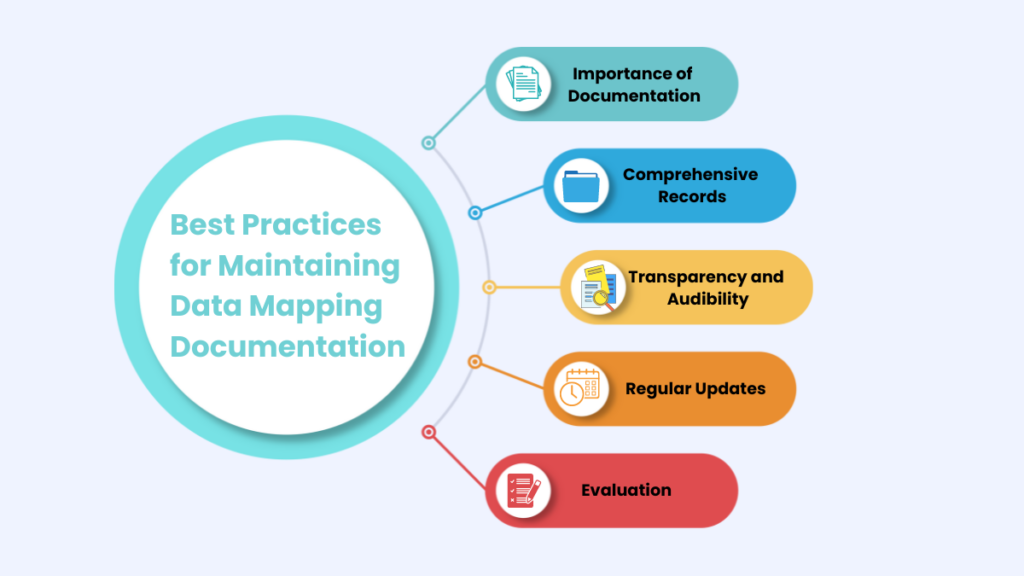
- Documentation Importance: Essential for maintaining data mapping integrity and effectiveness.
- Comprehensive Records: Include mapping policies, transformations, data lineage, and decision-making.
- Transparency and Audibility: Ensures transparent and traceable data mapping practices
- Regular Updates: Keep documentation current with evolving business needs and data landscape changes.
- Evaluation: Periodically assess documentation to ensure ongoing relevance and accuracy.
Future Trends in Data Mapping
As technology advances, here’s how data mapping is evolving, with key trends shaping its future
- Synthetic Intelligence (AI): AI algorithms automate complex data mapping tasks, enhancing efficiency.
- Cloud Computing: Cloud-based solutions provide scalability and flexibility for managing large data volumes.
- Innovative Solutions: Trends are shifting toward intelligent and agile data mapping tools.
- Cost-Effective: Modern data mapping solutions are increasingly cost-effective.
- Enhanced Data Utilization: These trends enable organisations to leverage their data assets fully.
Bottom Line
In conclusion, data mapping helps businesses organize information from different sources. It’s like creating a filing system to connect all your data together. This is becoming increasingly important as businesses collect more and more data. With the right tools, data mapping can improve accuracy, automate tasks, and save businesses time and money.
